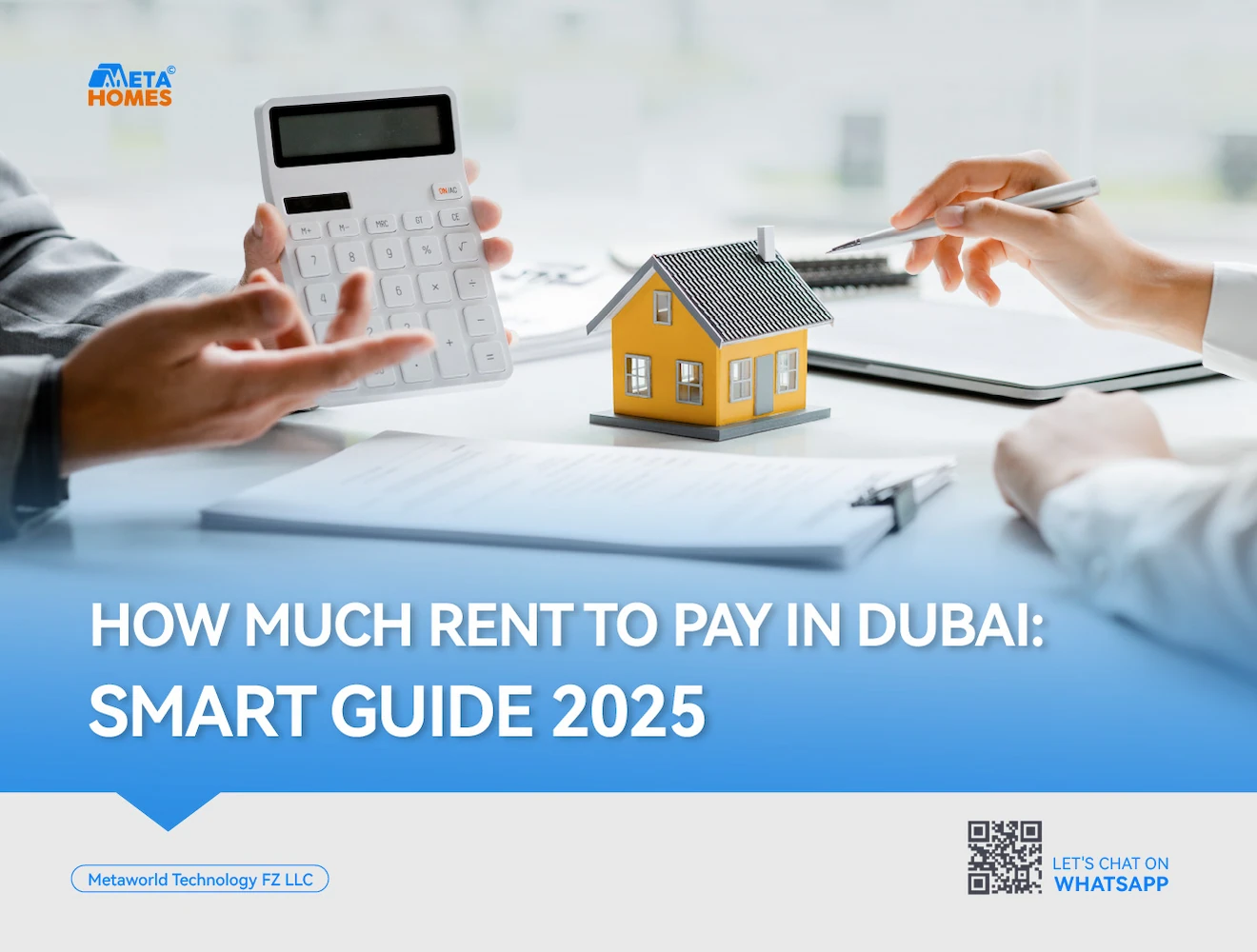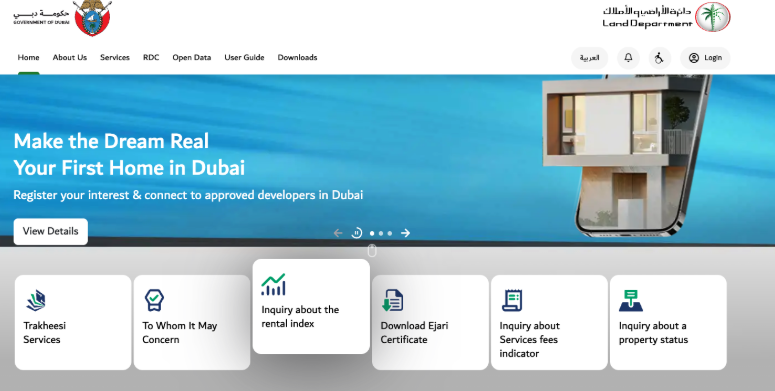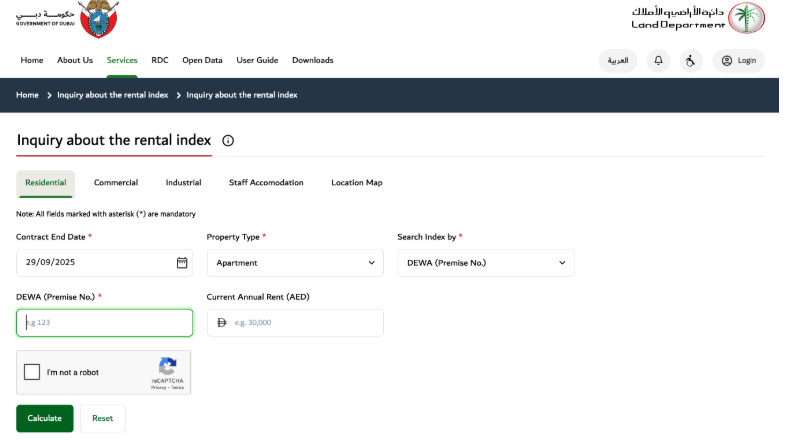
Renting a property in Dubai in 2025 is different from just a few years ago. With new regulations, better tools, and shifting demand, what counts as a “reasonable rent” for a studio flat, apartment, or villa depends on more factors than ever before.
Before we dig into numbers, let’s cover some fundamentals:
What “rent in Dubai” really means
When people talk about “rent in Dubai,” they typically refer to what you pay per year (or per month) for any rented property.
But that number rarely tells the full story. There are service charges, DEWA (electricity/water) fees, and maintenance to think about.
What the Smart Rental Index and RERA do
The Dubai Land Department (DLD) started the Dubai Smart Rental Index in 2025. This is a big change that is making rent increases fairer and more open.
This new index gives buildings a rating of 1 to 5 stars based on how well they are designed and maintained, as well as the services they offer (like parking and amenities).
Depending on this rating and how much less your rent is than the average, your landlord may or may not be able to raise the rent, and by how much.
The Real Estate Regulatory Agency (RERA) still uses rules based on the Smart Rental Index to set limits on how much rent can go up, so tenants are protected by law.
Key Terms to Know
Term Meaning
Ejari Dubai’s official rental contract registration system. If your lease isn’t registered via Ejari, you don’t get full legal protections.
Service Charges Costs for cleaning, security, and upkeep of the building and shared areas are often charged separately.
Annual vs. Monthly Rent Many rentals quote an annual figure (e.g. AED 60,000/year) which you pay in cheques, but they are often broken into monthly equivalents.
Market Rent / Fair Rent The rent value calculated using market data and indices, like the Smart Rental Index, which shows how much comparable properties go for.
How to Calculate the Right Rent Budget (Smart Guide for 2025)
The Dubai Rental Index, maintained by the Real Estate Regulatory Authority (RERA), is the official guide that sets the benchmark for rents across the city.
It was put in place to make the rental market easier to understand and to give landlords and tenants a clear idea of what to expect.
Instead of just looking at asking prices or negotiating with people, the index gives a standard way to figure out what is fair rent for each community.
Based on their type, size, and location, the index puts properties into groups. We look at townhouses, villas, and apartments one at a time. The rent range for each category depends on the number of bedrooms and the size of the city.
For example, renting a studio apartment in International City will cost less than renting a one-bedroom apartment in Downtown Dubai.
By entering the property details into the Dubai Land Department’s rental index calculator, available on their website or through the Dubai REST mobile application, the user can instantly see the official minimum and maximum rent allowed for that unit.
The rental index does a lot of important things, but one of the most important is to keep rent increases in check.
Landlords can’t just raise rents whenever they feel like it. They can only do it if the rent is much lower than the range set by the index.
Even if landlords want to increase, they have to follow the percentages set by RERA. This keeps tenants safe from sudden unexpected rental hikes.
The Rental Index is the legal reference point in the Rental Disputes Centre when there are disagreements. This gives both sides a clear set of rules to follow.
This means that if a tenant is paying AED 60,000 for a one-bedroom flat in Business Bay and the index shows that the fair range for that area is between AED 70,000 and AED 95,000, the landlord may be able to raise the rent as long as they stay within the law.
If the current rent is already in the range, on the other hand, the landlord can’t ask for a higher amount.
The Dubai Rental Index is a key part of the city’s housing market. It tells people what to expect when they want to rent a studio, an apartment, or even a villa.
It makes sure that the prices of rentals stay fair, stable, and in line with the market. This is important in a city that changes quickly and gets thousands of new people every year.
Rent Benchmarks & What You Should Expect in 2025
A studio in International City might cost between AED 30,000 and AED 40,000, but the same unit in Dubai Marina could easily cost between AED 55,000 and AED 75,000.
There is a reason for this difference: the rental index takes into account the demand, the quality of the community, and the facilities that are available.
The index is also clear for families who want to move into bigger homes. A two-bedroom flat in Jumeirah Village Circle could cost anywhere from AED 70,000 to AED 100,000.
A two-bedroom flat in Downtown Dubai or Palm Jumeirah, on the other hand, could cost AED 150,000 to AED 200,000 or more.
The index also makes sure that these numbers stay in a reasonable range and keeps landlords from charging too much above what is normal in the market.
Villas and townhouses are also included in the system. A three-bedroom villa in Arabian Ranches or The Springs is usually mapped at AED 160,000–250,000 a year, while luxury villas on the Palm Jumeirah or Emirates Hills are positioned much higher, sometimes crossing AED 1 million annually.
How to Use the Rental Index Calculator
Dubai Land Department has made the process of checking rents very simple through the Rental Index Calculator. Here is how to use it effectively.
- Go to the website of the Dubai Land Department and open the Rental Index Calculator. You will be directed to a dashboard as shown below

- Pick the type of home you want to rent: a townhouse, a villa, or an apartment.
- Choose the area or neighbourhood where your property is located (for example, Jumeirah Village Circle, Dubai Marina, or JLT).
- Enter how many bedrooms there are (studio, one bedroom, two bedrooms, three bedrooms, etc.).

- Click “search” to see the rental band. The tool will tell you how much you can expect to pay in rent each year for that kind of property in that area.
For example, if you type in “Apartment – 2 bedrooms – Dubai Marina,” the calculator might show a price range of AED 200,000 to AED 267,000 for 2025.
If your rent is already in this range, your landlord can’t raise it. The system lets you make a small, controlled change if it goes too low.
This calculator helps renters know that the rent they are paying is fair and follows the city’s rules.
It also gives landlords peace of mind that they are charging the right amount, which keeps them from getting into trouble or having to pay fines.
Localized Rent Benchmarks and What to Expect in 2025
Dubai’s rental market isn’t the same for everyone. The price of a studio flat for rent in Al Nahda, Dubai, is not even close to the price of one in Downtown Dubai.
A villa for rent in Arabian Ranches in Dubai feels very different from a villa for rent in Palm Jumeirah. Here’s a closer look at what people can expect in different communities in 2025.
Affordable Communities
Families and people looking for cheap apartments to rent in Dubai like these areas.
Community Property Type Typical Annual Rent (AED) Notes
Deira Studio apartment for rent in Deira 25,000 – 42,000 Older buildings, convenient for traders, near markets.
Deira is also a well-known traditional area that has kept the cultural heritage of UAE
/ 1-Bed flat for rent in Deira 45,000 – 65,000 /
Al Nahda / Al Qusais Studio in Al Nahda 32,000 – 45,000 Popular with families, lots of schools
Slightly older buildings but affordable
/ 2-Bedroom apartment 60,000 – 85,000 /
International City Studio apartments in International City 28,000 – 40,000 Compact, affordable, good for singles
Value for money, wide availability
/ 1-Bedroom apartment for rent in International City 40,000 – 55,000 /
Mid-Range Communities
There is a good mix of affordable and mid-range communities in Dubai. Mid-range communities are some of the highly searched rental areas in Dubai.
Here are some of the mid-range areas to live in Dubai, and how much you can expect to pay in rent:
Community Property Type Typical Annual Rent (AED) Notes
Dubai Silicon Oasis (DSO) Studio apartment for rent in Dubai Silicon Oasis 42,000 – 50,000 Affordable yet modern, lots of new towers
Good mix of family amenities
/ 2-Bedroom for rent in DSO 70,000 – 100,000 /
Jumeirah Village Circle (JVC) Studio flat for rent in JVC 44,000 – 55,000 Popular with young professionals
Stylish newer apartments
/ 1-Bedroom apartments in JVC 51,000 – 80,000 /
Discovery Gardens Studio for rent in Discovery Gardens 46,000 – 57,000 Family-oriented, easy access to Metro
Spacious layouts compared to city center
/ 2-Bedroom apartment for rent in Discovery Gardens 100,000 – 110,000 /
Prime and Lifestyle Communities
These places are closer to the city centre, with unmatched city views and lifestyle amenities. Prices are higher, but there’s still a considerable number of rental demands in these areas.
Community Property Type Typical Annual Rent (AED) Notes
Dubai Marina Studio in Dubai Marina 58,000 – 75,000 Waterfront, nightlife, lots of expats
High demand, sea-view units cost more
/ 1-Bedroom in DubI Marina 85,000 – 120,000 /
/ 3-Bedroom in Dubai Marina 126,000 – 200,000 /
Downtown Dubai Studio in Downtown Dubai 70,000 – 100,000 Burj Khalifa view premiums
Luxury lifestyle hub
Top-tier apartments
/ 1-Bed Flat 100,000 – 230,000 /
/ 2-Bedroom in Downtown Dubai 165,000 – 220,000 /
Business Bay Studio in Business Bay 60,000 – 75,000 Central, modern apartments
Mix of corporate tenants & families
/ 2-Bedroom in Business Bay 125,000 – 220,000 /
What Drives Rental Prices in Dubai?
While the Dubai Rental Index gives an official framework for rent, the actual price you see when searching for a flat for rent in Dubai or a villa in one of the city’s communities often depends on several real-world factors.
These go beyond just the property; they include the location, lifestyle, and even the long-term demand for the market.
Here are a few factors that influence rental prices in Dubai
Location & Community
The most important factor in Dubai’s rental prices is where the property is located. Downtown Dubai, Dubai Marina, and Palm Jumeirah are always among the most expensive places to live because they are central and well-connected.
You could pay almost twice as much for a studio flat in Dubai Marina as you would for a similar one in a suburban area like Al Qusais or International City.
You can expect to pay more the closer you are to major business centres, schools, and places to have fun.
Type and size of property
The type of property is very important. In Dubai, the price of a studio flat can be as low as AED 30,000 in less expensive areas and as high as AED 70,000 in more desirable areas.
A villa for rent in Dubai, on the other hand, might start at AED 120,000 in areas like Dubailand or Mirdif.
Luxury villas in Emirates Hills or Palm Jumeirah, on the other hand, can cost more than half a million dirhams a year.
Building Quality and Amenities
Not every building is the same. Naturally, newer buildings with modern finishes, smart home features, and high-end amenities like gyms, pools, and concierge services will demand more rental costs.
For example, a flat for rent in Dubai in a fully serviced tower can cost a lot more than a similar-sized apartment in an older building that doesn’t have any amenities. People are often willing to pay more for things that make their lives easier and more enjoyable
Demand and Rental Trends
The rental market in Dubai responds quickly to what people want. For example, when more people move to Dubai, rent tends to go up because more people want to live there.
On the other hand, landlords may lower rents or offer flexible payment plans to get tenants during slow times.
This means that prices are more stable in places with consistently high demand, like Business Bay or JLT, than in areas that are farther away.
Furnished vs Unfurnished Property for Rent in Dubai
The rent also depends on whether the property is furnished. A furnished studio flat for rent in Dubai usually costs 10% to 20% more than an unfurnished one.
Many new people prefer furnished options so they don’t have to deal with buying furniture right away, which keeps prices and demand high. These things all help to explain why rents in Dubai can be so different, even in the same neighbourhood.
The rental index sets the limits, but the final price you pay will depend on where you live, how big it is, how you live, and how much demand there is for it.
Important Points to Note:
When people talk about renting in Dubai, they mean a lot of different things. You can rent a small studio in Dubai for less than AED 40,000 in places like International City.
On the other hand, renting a luxury villa on Palm Jumeirah in Dubai can easily cost more than AED 1 million a year. That’s why it’s important to know your budget and lifestyle before you pick a place to live.
What “Dubai Rentals” Really Are (and Aren’t)
Don’t assume that the rent amount includes everything when you see it. Here are some extra costs that come up a lot:
– Service Charges / Maintenance: Buildings often charge extra for things like cleaning, the gym, the pool, landscaping, and other common areas.
– DEWA / Utilities: Water, electricity, and air conditioning are all separate.
– Parking and storage: Sometimes these are extra or included, depending on the property.
Furnishing: If it’s a furnished flat for rent in Dubai, expect higher rent. Unfurnished is cheaper.
How Rents Are Quoted & Paid
Many landlords quote the annual rent, e.g. “AED 120,000/year”, though tenants often pay in cheques (1–4 cheques per year is common).
Some landlords also allow monthly payments, but often at a slight premium.
Always check the per-square-foot rate to compare fairly across units of different sizes.
See More:
How to check rental property legality in UAE
Dubai RERA Rent Calculator: Check Allowable Rent Hike
Dubai Tenancy Laws 2025: What Every Renter Needs to Know



Leave a Reply